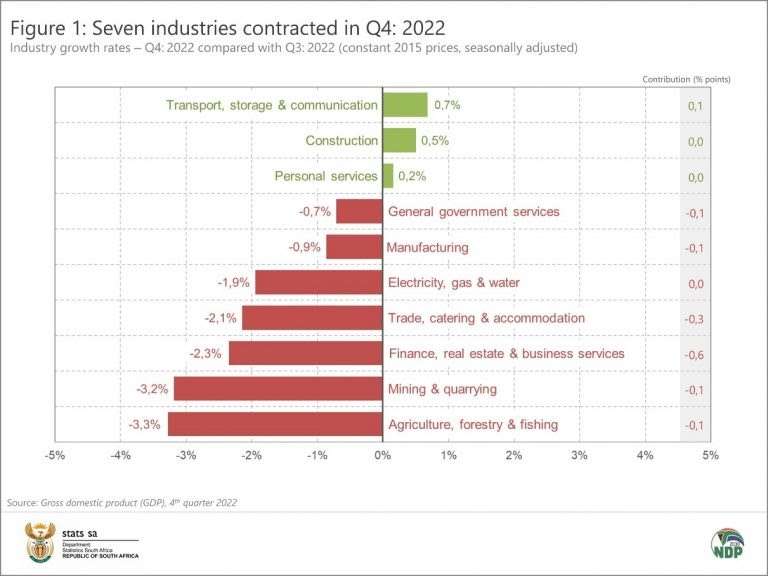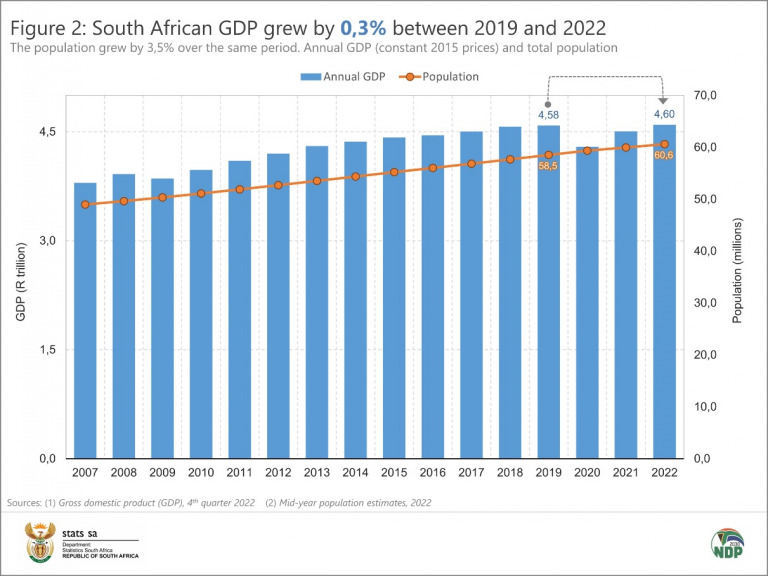South Africa’s economy declined more than expected in the fourth quarter of 2022.
After rallying in the third quarter of 2022, South African gross domestic product (GDP) declined by 1.3% in the fourth quarter (October‒December). Economists anticipated a decline of 0.4%.
According to Stats SA, growth was dragged lower mainly by finance, trade, mining, agriculture, manufacturing and general government services.
Seven of the ten industries contracted in the fourth quarter. The finance, real estate & business services industry shrank by 2.3%. This was on the back of lower economic activity in financial intermediation, insurance & pension funding and auxiliary activities.
As the finance, real estate & business services industry is the largest in the South African economy, the 2.3% decrease was the biggest factor behind the decline in GDP, subtracting 0.6 of a percentage point from GDP growth.
Agriculture recorded the largest contraction in the quarter (-3.3%), pulled lower mainly by weaker production figures for field crops and horticulture products.

On the positive side, transport, storage & communication, construction and personal services were the bright spots in the fourth quarter.
Transport, storage & communication made the largest positive impact, rising by 0.7% and contributing 0.1 of a percentage point to growth. This was mainly due to increased economic activity in passenger land transport, air transport and communication services.
Agriculture recorded the largest contraction in the quarter (-3.3%), pulled lower mainly by weaker production figures for field crops and horticulture products.
Recession warning
The shock GDP numbers for the quarter place South Africa on the precipice of a technical recession, with economists anticipating similar numbers for the first quarter of 2023.
The third quarter was marred by near-permanent load shedding, which has been in effect since September 2022. Only two days – at the start and at the end of October 2022 – featured no load shedding, with the rest of the quarter moving between stage 2 and stage 6 load shedding.
Every single day of the year so far has featured load shedding, continuing the trend. The key difference, however, is that load shedding stages have been far higher, with stage 6 load shedding sticking around for much longer.
Economists have warned that this is likely to have a dire effect on the economy, with conservative growth estimates for Q1 2023 pointing to a 0.4% decline.
Load shedding is such a crushing issue for the economy that the Reserve Bank has cut its growth projections for the year to a paltry 0.3%. This is based on the assumption that the country will experience 200 days of load shedding this year.
To date, the country has already seen 66 days of outages.
Annual GDP
Stats SA noted that economic growth in South Africa has been flat since 2019.
The fourth quarter data concludes the results for the calendar year, providing an opportunity to revisit the annual GDP series.
The South African economy grew for a second consecutive year, expanding by 2.0% between 2021 and 2022, from R4.50 trillion to R4.60 trillion. However, annual growth also undershot expectations – economists had pegged growth for the year at 2.3%.
Although GDP reached an all-time high in 2022, the economy has only grown by 0.3% from the 2019 pre-pandemic reading of R4.58 trillion. This lags behind the 3.5% rise in the country’s population over the same period, Stats SA said.

Exploring the economy in more detail, six industries have yet to recover to their pre-pandemic levels of production.
Construction is the worst in shape, remaining 23.1% smaller than what it was before the pandemic. In fact, construction’s woes started way before Covid-19. A shadow of its former self, 2022 marked construction’s sixth consecutive year of economic decline, the stats body said.
On the upside, South African agricultural activity was robust in the face of the pandemic.
The industry grew strongly in 2020 while many other industries faltered, following up with further gains in 2021 and 2022. The finance, real estate & business services industry also recorded positive growth figures for all three years, although not as strong as agriculture.

Source : Business Tech
















